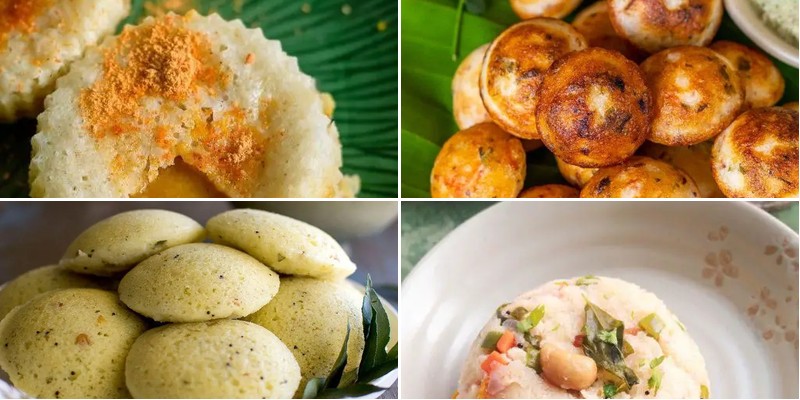Perfect for busy weeknights or lazy weekends, these 23 flavorful idli rava recipes bring the vibrant tastes of South Indian cuisine right to your North American kitchen. From quick breakfasts to satisfying dinners, discover how this versatile ingredient can transform your meals with minimal effort. Get ready to explore delicious, easy-to-make dishes that will become new family favorites—let’s dive in!
Classic Steamed Idli with Coconut Chutney
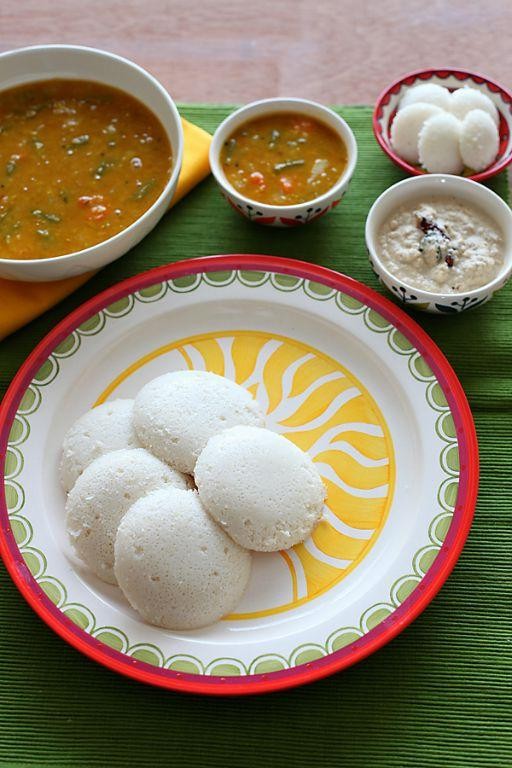
There’s something profoundly comforting about the gentle simplicity of steamed idli, those cloud-soft rice cakes that have graced South Indian breakfast tables for generations. Velvety in texture and subtly tangy from fermentation, they serve as the perfect canvas for vibrant coconut chutney, creating a harmonious balance of flavors that feels both nourishing and celebratory.
Ingredients
For the idli batter, you’ll need about 2 cups of idli rice, a half cup of urad dal, a teaspoon of fenugreek seeds, and a good pinch of salt. For steaming, just a light brushing of neutral oil for the molds. For the chutney, grab a cup of fresh grated coconut, a couple of green chilies, a small chunk of ginger, a handful of fresh cilantro, a tablespoon of chana dal, a squeeze of fresh lime juice, and a splash of water to get the consistency right. Don’t forget the tempering: a teaspoon of mustard seeds, a couple of dried red chilies, a sprinkle of asafoetida, and about 10 fresh curry leaves.
Instructions
1. Rinse 2 cups of idli rice, 1/2 cup urad dal, and 1 teaspoon fenugreek seeds separately under cold running water until the water runs clear.
2. Soak the rice mixture in 4 cups of water and the urad dal in 2 cups of water for 6 hours at room temperature, keeping them in separate bowls.
3. Drain the urad dal completely and grind it in a blender with 1/2 cup water for 15 minutes until it becomes light, fluffy, and doubles in volume.
4. Drain the rice mixture and grind it with 1/2 cup water for 20 minutes until it reaches a slightly grainy but smooth consistency.
5. Combine both batters in a large bowl, add 1 teaspoon salt, and mix thoroughly using your hand in one direction for 2 minutes to incorporate air.
6. Cover the bowl with a clean kitchen towel and let it ferment in a warm place (around 85°F) for 8-12 hours until the batter has risen and appears bubbly.
7. Lightly grease idli molds with neutral oil using a pastry brush, ensuring every cavity is coated.
8. Pour the fermented batter into the prepared molds, filling each cavity three-quarters full to allow for expansion.
9. Steam the idlis in a preheated steamer over medium-high heat for 10 minutes until a toothpick inserted comes out clean.
10. While the idlis steam, heat 1 tablespoon of oil in a small pan over medium heat until shimmering.
11. Add 1 teaspoon mustard seeds and wait until they begin to pop and dance in the oil, about 30 seconds.
12. Toss in 2 broken dried red chilies, a pinch of asafoetida, and 10 fresh curry leaves, frying for 15 seconds until the curry leaves crisp slightly.
13. Combine 1 cup grated coconut, 2 green chilies, 1-inch ginger piece, 1/4 cup cilantro, 1 tablespoon chana dal, and 1/2 cup water in a blender.
14. Blend the chutney ingredients for 2 minutes until completely smooth, scraping down the sides halfway through.
15. Transfer the chutney to a serving bowl and pour the hot tempering over the surface, listening for the satisfying sizzle.
16. Stir in 2 teaspoons of fresh lime juice until fully incorporated.
17. Remove the steamed idlis from the molds using a small spoon, working around the edges to release them intact.
Virtually weightless yet satisfyingly substantial, these idlis offer a delicate sponge-like texture that beautifully soaks up the chutney’s creamy-crunchy contrast. Serve them warm alongside the vibrant green chutney for a traditional experience, or get creative by using them as soft bases for mini appetizers topped with spiced vegetables or chutney-marinated shrimp for an elegant hors d’oeuvre.
Spicy Masala Idli Fries

Boldly reimagining South Indian comfort food, these Spicy Masala Idli Fries transform humble steamed cakes into crispy, golden batons infused with aromatic spices. The result is a textural revelation—crunchy exteriors giving way to soft, pillowy centers—that elevates street food to elegant appetizer status. Each bite delivers a sophisticated balance of heat, tang, and earthiness that will captivate even the most discerning palates.
Ingredients
– 8 leftover idlis, cut into fry-shaped batons
– 2 tablespoons vegetable oil
– 1 teaspoon mustard seeds
– a couple of dried red chilies, broken
– a generous pinch of asafoetida
– 10-12 fresh curry leaves
– 1 teaspoon red chili powder
– ½ teaspoon turmeric powder
– a splash of lemon juice
– a small handful of fresh cilantro, chopped
Instructions
1. Cut each leftover idli into ½-inch thick batons resembling french fries.
2. Heat 2 tablespoons vegetable oil in a large non-stick skillet over medium-high heat until shimmering (about 350°F).
3. Add 1 teaspoon mustard seeds and cook for exactly 30 seconds until they begin to pop and dance in the oil.
4. Toss in 2 broken dried red chilies and cook for 15 seconds until fragrant but not burned.
5. Sprinkle in a generous pinch of asafoetida and immediately add 10-12 fresh curry leaves, which will sizzle upon contact.
6. Quickly add the idli batons in a single layer, ensuring they don’t overlap for even crisping.
7. Cook undisturbed for 3 minutes until the bottoms develop a golden-brown crust.
8. Gently flip each baton using tongs and cook for another 3 minutes until uniformly crisp.
9. Reduce heat to low and evenly sprinkle 1 teaspoon red chili powder and ½ teaspoon turmeric powder over the fries.
10. Toss continuously for 1 minute to coat every surface without burning the spices.
11. Remove from heat and immediately drizzle with a splash of lemon juice.
12. Garnish with a small handful of chopped fresh cilantro.
Kaleidoscopic in both appearance and flavor, these fries offer a satisfying crunch that yields to tender interiors. The lingering heat from the chilies harmonizes beautifully with the citrus notes, making them perfect for dipping into cool mint chutney or pairing with an IPA. Serve them piled high on a slate board for dramatic presentation at your next gathering.
Idli Rava Upma with Vegetables
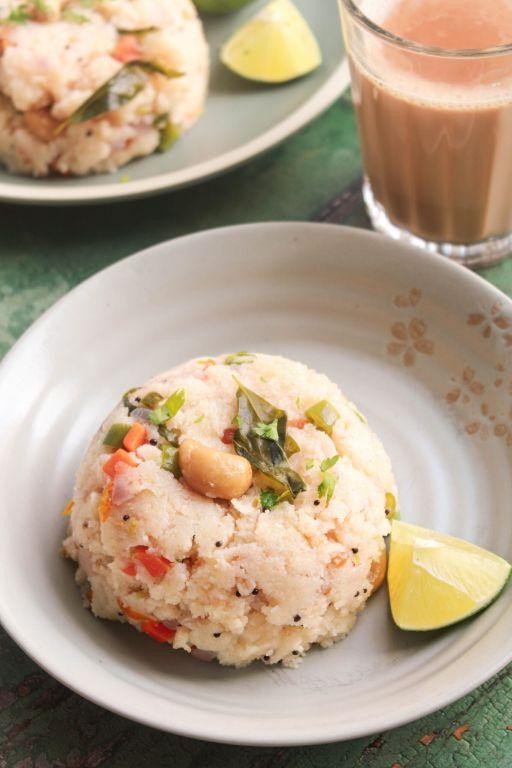
Savor the delicate fusion of South Indian tradition and contemporary vegetable medleys in this idli rava upma, where semolina pearls embrace colorful produce in a dish that feels both comforting and sophisticated. Steeped in aromatic spices and textural contrasts, this breakfast or light meal transforms humble ingredients into something truly memorable. Each bite offers a perfect balance of soft grains, crisp vegetables, and warming spices that will transport your senses to a sun-drenched morning in Chennai.
Ingredients
– 1 cup of idli rava (fine semolina)
– A good glug of vegetable oil (about 2 tablespoons)
– A teaspoon of mustard seeds
– A couple of dried red chilies
– A handful of curry leaves
– One medium onion, finely chopped
– A splash of water (about 2 cups)
– A pinch of turmeric powder
– A cup of mixed vegetables (carrots, peas, green beans)
– A squeeze of fresh lemon juice
– A sprinkle of chopped cilantro
Instructions
1. Dry roast 1 cup of idli rava in a pan over medium heat for 5 minutes, stirring constantly until it turns fragrant and light golden.
2. Heat 2 tablespoons of vegetable oil in the same pan over medium heat until it shimmers.
3. Add 1 teaspoon of mustard seeds and wait until they start popping, about 30 seconds.
4. Toss in 2 dried red chilies and a handful of curry leaves, frying for another 30 seconds until the leaves crisp up.
5. Stir in one finely chopped medium onion and cook for 4 minutes until translucent.
6. Mix in 1 cup of mixed vegetables and cook for 3 minutes until slightly tender.
7. Add a pinch of turmeric powder and stir for 30 seconds to bloom the spice.
8. Pour in 2 cups of water and bring to a rolling boil.
9. Reduce heat to low and gradually sprinkle in the roasted idli rava while stirring continuously to prevent lumps.
10. Cover the pan and cook for 5 minutes until the rava absorbs all the water.
11. Fluff the upma with a fork, then squeeze in fresh lemon juice to brighten the flavors.
12. Garnish with chopped cilantro and serve immediately.
Nothing compares to the upma’s delightful texture—fluffy semolina grains interspersed with crisp-tender vegetables create a satisfying mouthfeel. The subtle heat from chilies and aromatic curry leaves makes this dish particularly memorable when served alongside coconut chutney or a simple yogurt raita. For an elegant presentation, mold individual portions in small bowls and invert them onto plates, creating neat domes surrounded by vibrant accompaniments.
Crispy Fried Idli Rava Pakoras
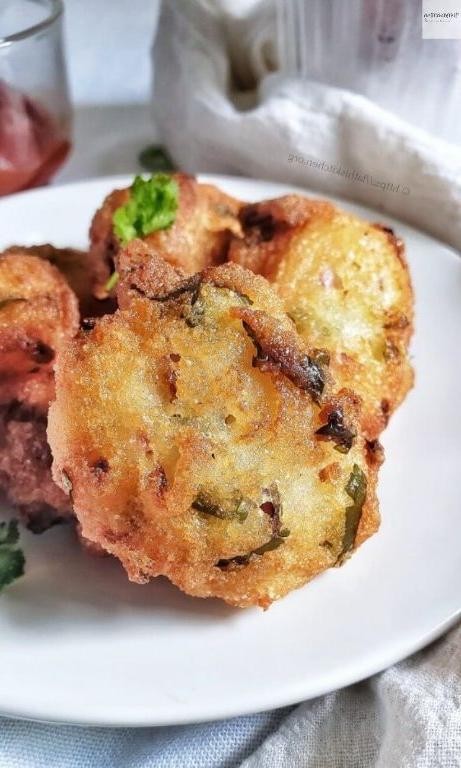
Rarely does a snack achieve such perfect harmony between crisp exterior and tender interior as these golden-fried idli rava pakoras. Reminiscent of savory doughnut holes with an Indian soul, these bite-sized delights transform humble semolina into something truly extraordinary, offering a satisfying crunch that gives way to a surprisingly light, fluffy center. They’re the kind of effortless elegance that makes casual entertaining feel like a curated culinary experience.
Ingredients
– About 1 cup of idli rava (fine semolina)
– A generous ½ cup of plain yogurt
– A couple of tablespoons of finely chopped onion
– A tablespoon of fresh cilantro, roughly chopped
– A teaspoon of grated ginger
– A green chili or two, finely minced (depending on your heat preference)
– A pinch of cumin seeds
– A good sprinkle of salt
– A splash of water if needed
– Enough vegetable oil for deep frying (about 2-3 cups)
Instructions
1. Combine 1 cup of idli rava, ½ cup of plain yogurt, 2 tablespoons of chopped onion, 1 tablespoon of cilantro, 1 teaspoon of grated ginger, 1-2 minced green chilies, a pinch of cumin seeds, and a generous sprinkle of salt in a mixing bowl.
2. Mix everything thoroughly until a thick, cohesive batter forms, adding a splash of water only if the mixture feels too dry to hold together.
3. Let the batter rest for exactly 15 minutes to allow the semolina to absorb moisture and soften properly—this prevents the pakoras from becoming dense.
4. Meanwhile, pour 2-3 cups of vegetable oil into a heavy-bottomed pot and heat it to 350°F, using a deep-fry thermometer to ensure accuracy.
5. Test the oil temperature by dropping a tiny bit of batter; it should sizzle immediately and rise to the surface without browning too quickly.
6. Using lightly oiled hands, gently shape tablespoon-sized portions of the batter into rough balls, being careful not to overwork them—this keeps the texture light.
7. Carefully slide 4-5 balls into the hot oil at a time, avoiding overcrowding to maintain consistent temperature and crispiness.
8. Fry for 3-4 minutes, turning occasionally with a slotted spoon, until they achieve a deep golden-brown color with a crisp exterior.
9. Remove the pakoras with a slotted spoon and drain them on a wire rack set over a baking sheet rather than paper towels—this prevents sogginess by allowing air circulation.
10. Repeat the frying process with the remaining batter, allowing the oil to return to 350°F between batches for optimal results.
What makes these pakoras truly memorable is their delightful textural contrast—the shatteringly crisp crust giving way to a soft, almost cake-like interior that’s subtly tangy from the yogurt. Serve them immediately with mint chutney for dipping, or for an unexpected twist, tuck a few into mini brioche buns with a swipe of spicy mayo for the most elegant slider you’ll ever encounter.
Savory Rava Idli with Curry Leaves
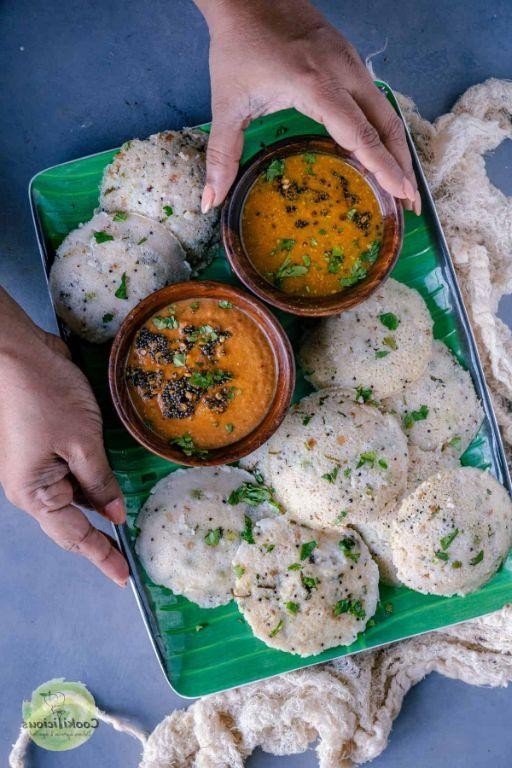
Just when you thought traditional idli couldn’t be more comforting, this savory rava version infused with fragrant curry leaves elevates the classic South Indian breakfast to new heights of flavor and sophistication. Jewel-toned with turmeric and aromatic with mustard seeds, these steamed cakes offer a delightful textural contrast between their soft interiors and delicate, crisp edges.
Ingredients
– 1 cup of semolina (rava)
– A generous splash of plain yogurt
– About 1 cup of water
– A couple of tablespoons of vegetable oil
– A teaspoon of black mustard seeds
– A small handful of fresh curry leaves
– A pinch of asafoetida (hing)
– Half a teaspoon of turmeric powder
– A teaspoon of finely chopped green chilies
– A tablespoon of grated fresh ginger
– A good squeeze of lemon juice
– A sprinkle of salt
Instructions
1. Heat 1 tablespoon of vegetable oil in a skillet over medium heat until it shimmers.
2. Add 1 teaspoon of black mustard seeds and cook until they begin to pop, about 30 seconds.
3. Stir in a small handful of fresh curry leaves and cook until they become crisp and fragrant, approximately 1 minute.
4. Mix in a pinch of asafoetida, half a teaspoon of turmeric powder, 1 teaspoon of chopped green chilies, and 1 tablespoon of grated ginger, cooking for another minute until aromatic.
5. Add 1 cup of semolina to the skillet and toast, stirring constantly, until it turns light golden and smells nutty, about 3-4 minutes.
6. Transfer the toasted semolina mixture to a large bowl and let it cool completely to room temperature, which prevents the yogurt from curdling.
7. Whisk in a generous splash of plain yogurt until the mixture is smooth and well-combined.
8. Gradually add about 1 cup of water, stirring continuously, until you achieve a thick but pourable batter consistency.
9. Cover the bowl and let the batter rest for 20 minutes to allow the semolina to absorb the liquid and soften.
10. After resting, stir in a good squeeze of lemon juice and a sprinkle of salt until fully incorporated.
11. Grease idli molds or small ramekins lightly with the remaining vegetable oil.
12. Pour the batter into the prepared molds, filling each about three-quarters full to allow for expansion.
13. Steam the idlis in a steamer over boiling water for 12-15 minutes, or until a toothpick inserted into the center comes out clean.
14. Remove the idlis from the steamer and let them rest for 2 minutes before carefully unmolding.
Now, these golden-hued idlis boast a wonderfully fluffy interior with a subtle crunch from the toasted semolina, while the curry leaves and mustard seeds create bursts of aromatic flavor in every bite. Serve them warm with coconut chutney for a traditional touch, or get creative by pairing them with a spicy tomato soup for an elegant twist that highlights their savory depth.
Sweet Jaggery Idli Rava Pudding
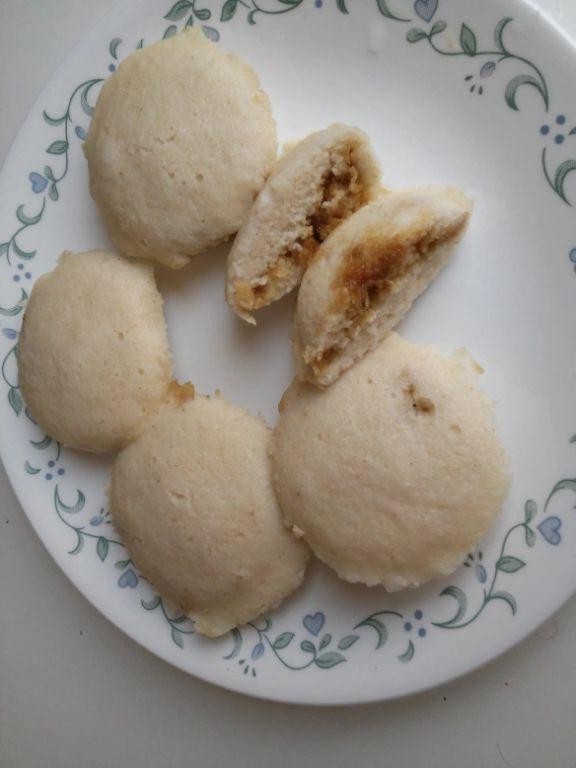
Delicately bridging the gap between traditional Indian sweets and contemporary American desserts, this jaggery-infused rava pudding transforms humble semolina into an elegant, aromatic treat that comforts with every spoonful. During the autumn months when warmth is craved, its golden hue and cardamom-kissed fragrance create an irresistible invitation to indulge. Developed through generations yet perfectly suited for modern kitchens, this pudding offers both nostalgic familiarity and sophisticated flavor complexity.
Ingredients
– 1 cup of fine semolina (rava)
– ¾ cup of grated jaggery (that lovely unrefined cane sugar)
– 2 cups of whole milk
– A generous splash of ghee (about 3 tablespoons)
– A handful of raw cashews and golden raisins
– A couple of cardamom pods, freshly crushed
– A pinch of fine sea salt
Instructions
1. Heat 2 tablespoons of ghee in a heavy-bottomed pan over medium heat until it shimmers.
2. Add the cashews and raisins, toasting them for about 2 minutes until the cashews turn golden and the raisins plump up beautifully.
3. Tip in the semolina and roast for 6-8 minutes, stirring constantly, until it releases a nutty aroma and turns light golden—this deep toasting prevents lumping later.
4. Meanwhile, warm the milk in a separate saucepan until steaming but not boiling, about 180°F.
5. Carefully pour the hot milk into the roasted semolina, stirring vigorously to incorporate and prevent any clumps from forming.
6. Cook the mixture over medium-low heat for 5 minutes, stirring frequently as it thickens to a porridge-like consistency.
7. Stir in the grated jaggery and crushed cardamom, cooking for another 3-4 minutes until the jaggery completely dissolves and the pudding thickens further.
8. Add the final tablespoon of ghee and pinch of salt, stirring for one final minute to create a glossy, cohesive pudding.
9. Remove from heat and let rest covered for 10 minutes—this allows the semolina to fully absorb the liquids and develop its texture.
Heavenly when served warm, this pudding offers a delightful contrast between the creamy semolina base and the occasional burst of plump raisins. The jaggery provides a complex caramel depth that refined sugar simply cannot replicate, while the cardamom lingers as a sophisticated finish. Consider serving it in individual ramekins topped with a drizzle of warm milk and extra toasted nuts for an elegant presentation that belies its simple preparation.
Idli Rava Dosa with Spiced Potato Filling
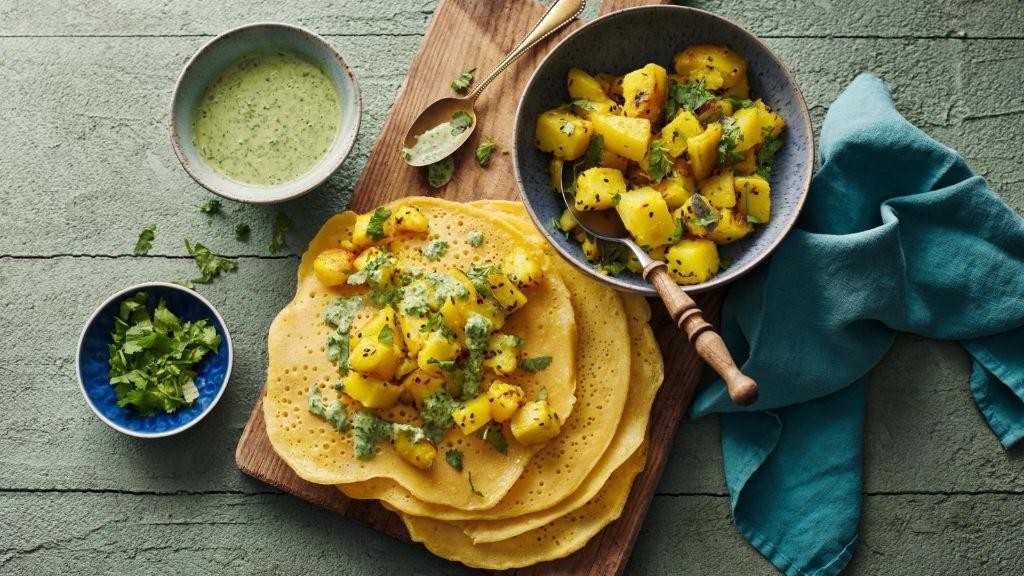
Zestfully bridging the gap between traditional South Indian cuisine and modern American kitchens, this crispy, lacy crepe with its warmly spiced potato filling offers both comfort and sophistication. The delicate rava dosa, golden and intricately patterned, cradles a savory potato masala that sings with aromatic spices. It’s a dish that transforms simple ingredients into an elegant breakfast or brunch centerpiece, perfect for those seeking culinary adventure with approachable elegance.
Ingredients
– 1 cup of semolina (rava)
– A couple of tablespoons of rice flour
– A splash of buttermilk
– About 2 cups of water
– A pinch of asafoetida
– A drizzle of vegetable oil
– 2 medium potatoes, boiled and mashed
– A spoonful of mustard seeds
– A handful of curry leaves
– One finely chopped onion
– A couple of green chilies, sliced
– A teaspoon of turmeric powder
– A sprinkle of salt
Instructions
1. Combine 1 cup of semolina, 2 tablespoons of rice flour, a pinch of asafoetida, and a sprinkle of salt in a large bowl.
2. Whisk in a splash of buttermilk and about 2 cups of water until the batter is smooth and thin, like crepe batter, then let it rest for 20 minutes to allow the semolina to hydrate.
3. Heat a drizzle of vegetable oil in a skillet over medium heat and add a spoonful of mustard seeds, cooking until they pop, about 30 seconds.
4. Stir in one finely chopped onion, a handful of curry leaves, and a couple of sliced green chilies, sautéing until the onion turns translucent, roughly 3-4 minutes.
5. Mix in a teaspoon of turmeric powder and cook for 30 seconds to release its aroma.
6. Fold in 2 boiled and mashed potatoes and a sprinkle of salt, stirring to combine evenly, then remove from heat to set aside as the filling.
7. Heat a non-stick griddle or skillet over medium-high heat until a drop of water sizzles and evaporates instantly.
8. Stir the rested batter and ladle it onto the hot surface, starting from the edges and moving inward in a circular motion to create a lacy pattern.
9. Drizzle a bit of vegetable oil around the edges and cook for 2-3 minutes until the bottom is golden and crisp.
10. Flip the dosa carefully and cook the other side for 1-2 minutes until lightly browned.
11. Spoon a portion of the spiced potato filling onto one half of the dosa.
12. Fold the dosa over the filling and serve immediately.
The result is a textural delight—crisp, lacy edges giving way to a soft, fluffy interior enveloping the warmly spiced potatoes. Serve it alongside coconut chutney for a contrasting coolness or with a zesty tomato salsa to highlight its savory notes, making each bite a harmonious blend of crunch and comfort.
Quick Instant Rava Idli with Yogurt
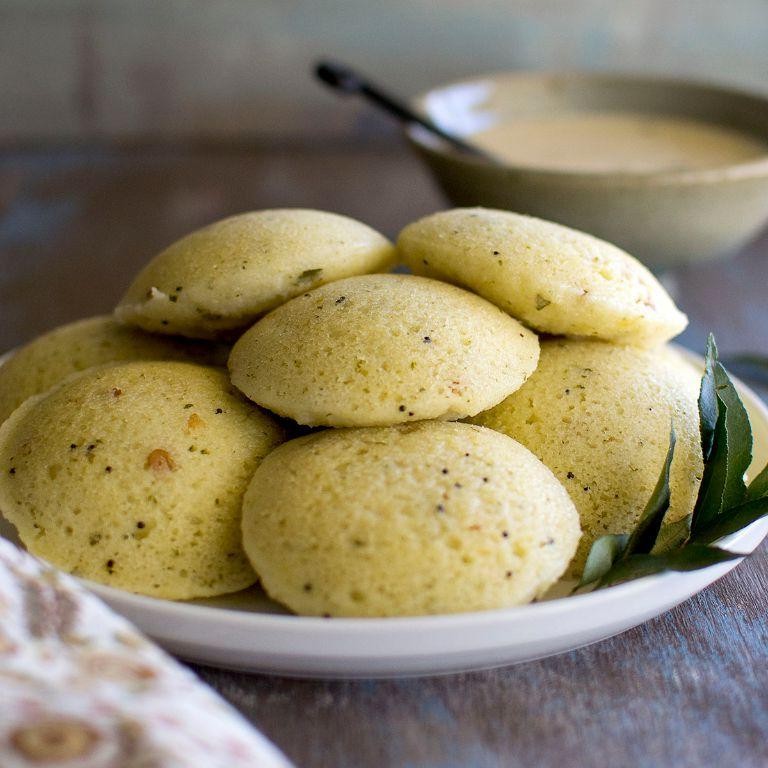
Fusing the delicate texture of traditional South Indian steamed cakes with modern convenience, these Instant Rava Idli offer a sophisticated twist on breakfast simplicity. Prepared with creamy yogurt and semolina, they achieve an airy, cloud-like crumb that belies their quick preparation. This elegant adaptation brings restaurant-quality results to your morning routine in mere minutes.
Ingredients
– About 1 cup of fine semolina (rava)
– A generous ½ cup of plain whole milk yogurt
– Roughly ¾ cup of water
– A splash of vegetable oil
– A couple of teaspoons of baking soda
– A pinch of salt
– A handful of mustard seeds
– A scattering of fresh curry leaves
Instructions
1. Combine 1 cup of fine semolina, ½ cup of plain whole milk yogurt, and ¾ cup of water in a medium bowl.
2. Whisk the mixture vigorously for 2 minutes until completely smooth and free of lumps.
3. Cover the bowl with a clean kitchen towel and let the batter rest at room temperature for exactly 20 minutes to allow the semolina to hydrate properly.
4. Heat 1 tablespoon of vegetable oil in a small skillet over medium heat until it shimmers.
5. Add 1 teaspoon of mustard seeds and cook for 45 seconds until they begin to pop and become fragrant.
6. Stir in 8-10 fresh curry leaves and cook for another 30 seconds until they crisp slightly and release their aroma.
7. Pour the entire tempering mixture into the rested batter and fold gently to incorporate.
8. Add 2 teaspoons of baking soda and a generous pinch of salt to the batter.
9. Mix quickly but gently until just combined—the batter will become slightly frothy as the baking soda activates.
10. Fill each idli mold cavity ¾ full with batter using a ladle, being careful not to overfill.
11. Place the idli stand in a steamer with 2 inches of boiling water and cover tightly.
12. Steam over medium-high heat for exactly 12 minutes until the idlis are puffed and firm to the touch.
13. Remove the idli stand from the steamer and let cool for 3 minutes before gently loosening the edges with a butter knife.
Achieving an exceptionally light, spongy texture that melts delicately on the tongue, these idli carry subtle tanginess from the yogurt balanced by the aromatic tempering. Serve them warm with coconut chutney for traditional elegance, or create miniature versions as sophisticated hors d’oeuvres for your next gathering.
Idli Rava Uttapam with Fresh Tomatoes
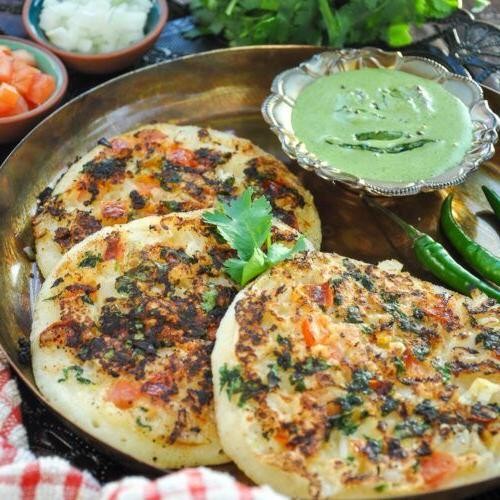
Delightfully bridging the gap between traditional idli and contemporary breakfast fare, this Idli Rava Uttapam with Fresh Tomatoes offers a sophisticated twist on South Indian classics. Distinctive for its delicate, porous texture and vibrant tomato topping, this dish transforms simple ingredients into an elegant morning centerpiece. Developed with the modern home cook in mind, it maintains authentic flavors while streamlining preparation for busy weekdays.
Ingredients
– 1 cup of idli rava (semolina)
– A generous ½ cup of plain yogurt
– About ¾ cup of water
– A good pinch of salt
– A couple of ripe tomatoes, thinly sliced
– A small handful of fresh cilantro, chopped
– A splash of vegetable oil for cooking
Instructions
1. Combine 1 cup of idli rava with ½ cup of plain yogurt in a medium bowl.
2. Gradually add ¾ cup of water while whisking to create a smooth, lump-free batter with pancake-like consistency.
3. Mix in a generous pinch of salt until fully incorporated.
4. Let the batter rest for 15 minutes at room temperature to allow the rava to absorb moisture and soften properly.
5. Heat a non-stick skillet over medium heat until a water droplet sizzles immediately upon contact.
6. Lightly grease the skillet with vegetable oil using a pastry brush or paper towel.
7. Pour ¼ cup of batter onto the hot skillet, gently spreading it into a 5-inch circle about ¼-inch thick.
8. Immediately arrange 3-4 thin tomato slices evenly across the surface of the uttapam.
9. Sprinkle a tablespoon of chopped cilantro over the tomatoes.
10. Cook for 3-4 minutes until the edges appear dry and the bottom develops golden-brown spots.
11. Carefully flip the uttapam using a wide spatula when the surface looks set and no longer wet.
12. Cook the second side for 2-3 minutes until lightly golden and cooked through.
13. Transfer to a wire rack to maintain crispness rather than stacking directly.
14. Repeat with remaining batter, greasing the skillet between each uttapam.
You’ll find the texture wonderfully crisp on the exterior while remaining tender and airy inside, creating a delightful contrast. The sweet acidity of the tomatoes beautifully complements the subtle tang from the yogurt batter, making each bite perfectly balanced. Consider serving these uttapams with a zesty mint chutney or alongside a simple lentil soup for a complete, satisfying meal that feels both rustic and refined.
Fermented Rava Idli with Mint Chutney
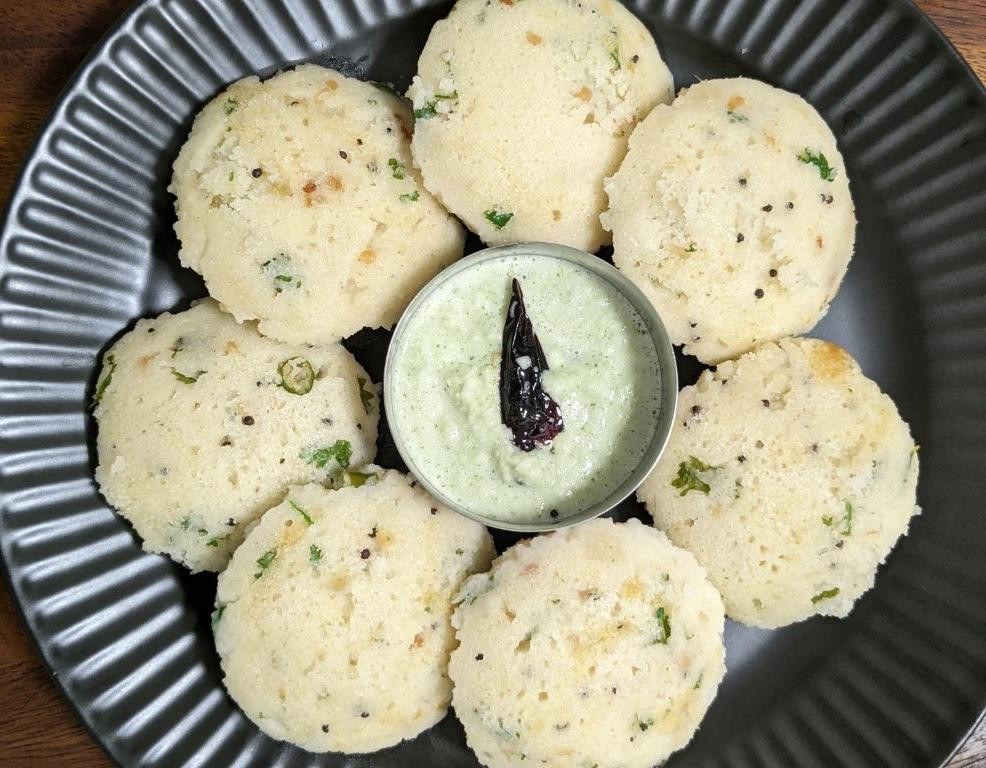
Rarely does a dish so humble in its origins achieve such sophisticated complexity, yet fermented rava idli with mint chutney accomplishes precisely that—transforming simple semolina into ethereal, spongy cakes elevated by the vibrant freshness of herbal accompaniment.
Ingredients
– 1 cup of semolina (rava)
– ½ cup of plain yogurt
– A splash of water, just enough to make a batter
– A pinch of baking soda
– A drizzle of vegetable oil for greasing
– A generous handful of fresh mint leaves
– A couple of green chilies
– A small squeeze of lemon juice
– A tiny spoonful of sugar
– A sprinkle of salt
Instructions
1. Combine 1 cup of semolina, ½ cup of plain yogurt, and a splash of water in a bowl, mixing until you achieve a thick, lump-free batter.
2. Cover the bowl with a clean cloth and let it ferment at room temperature (around 70°F) for 8–10 hours, or until the batter appears slightly bubbly and has a subtle tangy aroma—this slow fermentation is key for developing the idli’s characteristic airy texture.
3. Stir a pinch of baking soda into the fermented batter just before steaming to ensure the idlis rise properly.
4. Lightly grease the idli molds with vegetable oil using a pastry brush for even coverage.
5. Pour the batter into each mold, filling them three-quarters full to allow space for expansion.
6. Steam the idlis in a preheated steamer over medium-high heat for 12–15 minutes, or until a toothpick inserted into the center comes out clean—avoid oversteaming to prevent dryness.
7. While the idlis steam, blend a generous handful of mint leaves, a couple of green chilies, a small squeeze of lemon juice, a tiny spoonful of sugar, and a sprinkle of salt in a blender until smooth, scraping down the sides as needed for consistency.
8. Carefully remove the steamed idlis from the molds using a butter knife to loosen the edges.
9. Serve the warm idlis immediately with the freshly prepared mint chutney. Unbelievably light and porous, these idlis practically melt on the tongue, their subtle tang perfectly balanced by the chutney’s zesty kick. For a creative twist, layer them with roasted vegetables for an open-faced sandwich, letting the spongy texture soak up any added dressings or sauces.
Idli Rava Paniyaram with Onion Relish
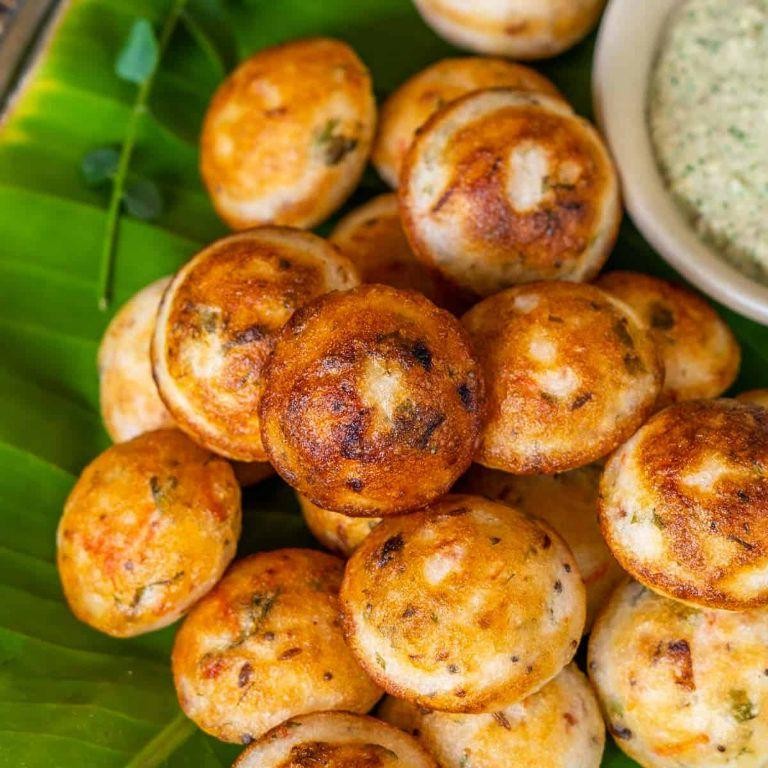
A sophisticated twist on traditional South Indian street food, these delicate idli rava paniyaram offer a delightful textural contrast between their crisp golden exteriors and soft, steaming interiors. Anointed with a vibrant onion relish that balances sweet caramelization with bright acidity, this dish transforms humble ingredients into an elegant breakfast or appetizer worthy of any brunch gathering.
Ingredients
– 1 cup of idli rava (semolina)
– A generous ½ cup of plain yogurt
– About ¾ cup of water
– A good pinch of baking soda
– A couple of tablespoons of vegetable oil for the paniyaram pan
– 2 medium yellow onions, finely chopped
– A splash of vegetable oil for sautéing
– 1 teaspoon of mustard seeds
– 2 dried red chilies
– A handful of fresh curry leaves
– A squeeze of fresh lime juice
Instructions
1. Combine 1 cup of idli rava, ½ cup of plain yogurt, and ¾ cup of water in a mixing bowl, stirring until no dry spots remain.
2. Cover the bowl and let the batter rest at room temperature for exactly 20 minutes to allow the rava to hydrate fully—this prevents graininess in the final texture.
3. While the batter rests, heat a splash of vegetable oil in a skillet over medium heat until it shimmers, about 1 minute.
4. Add 1 teaspoon of mustard seeds to the hot oil and cook until they begin to pop and dance in the pan, approximately 30 seconds.
5. Toss in 2 dried red chilies and a handful of fresh curry leaves, stirring for 20 seconds until the curry leaves crisp slightly and become fragrant.
6. Add 2 finely chopped medium yellow onions to the skillet and sauté, stirring occasionally, for 8-10 minutes until they turn translucent with golden edges.
7. Remove the skillet from heat and stir in a squeeze of fresh lime juice, then set the onion relish aside.
8. Stir a good pinch of baking soda into the rested batter—this creates tiny air pockets for lighter paniyaram.
9. Heat a paniyaram pan over medium heat and brush each mold with about ½ teaspoon of vegetable oil, heating until the oil sizzles when a drop of batter is added.
10. Fill each mold three-quarters full with batter and cook for 3-4 minutes until the bottoms develop a deep golden-brown crust and the tops appear set with small holes.
11. Carefully flip each paniyaram using a skewer or small spoon and cook for another 2-3 minutes until both sides are evenly golden brown.
12. Transfer the cooked paniyaram to a plate and top each with a spoonful of the prepared onion relish.
Now these golden dumplings emerge with a satisfying crispness that yields to a featherlight interior, while the relish provides a sweet-savory counterpoint with occasional bursts of chili heat. Consider serving them alongside a cooling cucumber raita or stacking them as elegant canapés for your next gathering, where their intricate spicing will undoubtedly spark conversation.
Fluffy Rava Idli Cake with Sambar Sauce

Beneath its golden exterior lies a delicate fusion of South Indian tradition and contemporary baking artistry—this rava idli cake transforms the beloved steamed semolina dumpling into an elegant, oven-baked centerpiece. Perfect for brunch gatherings or a comforting weekend project, it pairs exquisitely with a deeply spiced sambar sauce that whispers of toasted cumin and tamarind’s tang. Each slice offers a tender, porous crumb, ready to soak up the vibrant, broth-like accompaniment.
Ingredients
– 1 cup of fine semolina (rava)
– a generous ½ cup of plain yogurt
– a splash of water, about ¼ cup
– a couple of tablespoons of vegetable oil
– 1 teaspoon of baking soda
– a pinch of asafoetida (hing)
– 1 teaspoon of black mustard seeds
– a handful of fresh curry leaves
– 2 dried red chilies, snapped in half
– 1 tablespoon of urad dal
– 1 tablespoon of chana dal
– 1 finely chopped small onion
– 1 diced tomato
– ½ cup of chopped mixed vegetables (like carrots and green beans)
– 1 tablespoon of sambar powder
– ¼ teaspoon of turmeric powder
– a squeeze of tamarind paste, about 1 teaspoon
– a sprinkle of salt, to season
Instructions
1. Preheat your oven to 350°F and lightly grease an 8-inch round cake pan with a thin layer of vegetable oil.
2. In a large mixing bowl, combine 1 cup of fine semolina, a generous ½ cup of plain yogurt, a splash of water (about ¼ cup), and 1 teaspoon of baking soda, stirring until no dry patches remain—let this batter rest for 15 minutes to allow the semolina to soften, which ensures a fluffier texture.
3. Pour the rested batter into the prepared cake pan and bake for 25–30 minutes, or until the top is golden brown and a toothpick inserted into the center comes out clean.
4. While the cake bakes, heat 1 tablespoon of vegetable oil in a medium saucepan over medium heat until it shimmers.
5. Add 1 teaspoon of black mustard seeds and cover the pan briefly until you hear them pop, about 30 seconds, to prevent splattering.
6. Stir in a pinch of asafoetida, 2 dried red chilies (snapped in half), a handful of fresh curry leaves, 1 tablespoon of urad dal, and 1 tablespoon of chana dal, toasting for 1–2 minutes until the dals turn light golden and fragrant.
7. Add 1 finely chopped small onion and sauté for 3–4 minutes until it turns translucent and soft.
8. Mix in 1 diced tomato, ½ cup of chopped mixed vegetables (like carrots and green beans), 1 tablespoon of sambar powder, ¼ teaspoon of turmeric powder, and a sprinkle of salt, cooking for another 3–4 minutes until the tomatoes break down.
9. Pour in 2 cups of water and bring the mixture to a gentle boil, then reduce the heat to low and simmer for 10–12 minutes until the vegetables are tender but not mushy.
10. Stir in a squeeze of tamarind paste (about 1 teaspoon) and simmer for an additional 2 minutes to meld the flavors, then remove from heat.
11. Let the baked rava idli cake cool in the pan for 5 minutes before turning it out onto a wire rack.
Zestfully slice the warm cake into wedges and ladle the sambar sauce alongside, allowing the porous crumb to absorb the tangy, spiced broth. The result is a harmonious blend of soft, cake-like idli with the earthy depth of sambar—ideal for serving as a brunch centerpiece or drizzling with extra sauce for a cozy dinner. Its light, airy texture contrasts beautifully with the chunky vegetables, making each bite a celebration of comfort and sophistication.
Conclusion
Ranging from breakfast to dinner, these 23 idli rava recipes offer endless versatility for your kitchen. We hope these creative dishes inspire you to explore new flavors! Try your favorites and let us know which ones you love in the comments below. Don’t forget to share this delicious collection with fellow food lovers by pinning it on Pinterest!
